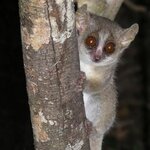Ecology & Zoology

A new paper detailing research from the rainforests of Panama provides an unprecedented level of detail regarding the diversity and distribution of arthropod species from the soil to the forest canopy - the authors estimate that a 6,000 hectare forest hosts a total of around 25,000 arthropod species, a figure vastly outnumbering that of better-studied organisms.
Most multicellular species on Earth are arthropods living in tropical forests. Yet, given the difficulties involved in merely tallying them, we know very little about their exact numbers– even at the scale of a single…

In America, human women wake up every day and decide whether they want to have sex or not. They know somewhere a man is willing to make that happen.
In bushcrickets, the male is in charge.
When bushcrickets mate, the male attaches a spermatophore to the female's abdomen. Alongside the sperm themselves, the spermatophore contains a protein-rich mass that the female eats after mating. It then takes several hours for the sperm to find their way into the female's reproductive tract.
Who decides when this 'bridal present' is delivered? A paper by Bielefeld biologists…

The slow loris (Nycticebus) is a primate genus closely related to the lemur and found across South East Asia, from Bangladesh and China's Yunnan province to the island of Borneo.
The slow loris is rare amongst primates for having a toxic bite, and is rated as Vulnerable or Endangered on the IUCN Red List. Maybe not so endangered, since researchers have found a brand new species. A team's analysis of the primate's distinctive facial fur markings, published in the American Journal of Primatology, reveals the existence of one entirely new species, while two possible sub-species are being…

Researchers have announced discovery of a species of animal related to crabs, lobsters and shrimps that is new to science.
A tiny shelled arthropod was found in 425 million-year-old rocks in Herefordshire, Welsh Borderland. The rocks at the site date to the Silurian period of geological time, when southern Britain was a sea area on a small continent situated in warm, southerly subtropical latitudes. The ostracods and associated marine animals living there were covered by a fall of volcanic ash that preserved them frozen in time.
The new, 10 millimeter long fossil is special because it is…

If you are in the Western world, you likely know the tale of the Three Wise Men who brought gifts for the baby Jesus. The value of gold is still obvious today, but while people have heard of myrrh and frankincense, most don't know what they were for, or why anyone would bring them all that distance to give to a newborn.
Frankincense and myrrh are fragrances that were quite valuable at the time and just as impractical for a baby as gold - but they are also still big business today, though not quite as valuable as gold. Just in Ethiopia, frankincense is a 4,000 ton per year industry. One…

What Charles Darwin famously called "an abominable mystery", the apparent sudden appearance and rapid spread of flowering plants in the fossil record, is the topic of a paper which proposes new evidence that flowering plants - angiosperms - evolved and colonized various types of aquatic environments over about 45 million years in the early to middle Cretaceous Period.
The researchers draw on fossil data from Europe to create a picture of how angiosperms evolved, and it connects their evolution with changes in the physical and biological environments. They say the scenario is consistent with…

Plant growth patterns are influenced by a variety of stimuli, including gravity. Terrestrial plant roots exhibit characteristic behaviors called 'waving' and 'skewing' and those are thought to be gravity-dependent events.
Not so, according to a study of Arabidopsis plants grown on the International Space Station (ISS). Root 'waving' and 'skewing' occur even with no gravity.
In plant roots, 'waving' consists of a series of regular, undulating changes in the direction of root tips during growth. It is thought to be associated with perception and avoidance of obstacles, and is…

Scientists have reaffirmed that pollinator services of large agriculture fields can be enhanced with a simple cost-effective measure - the creation of small patches of native plants within fruit orchards.
While pesticide use and isolation from natural habitat lead to declines in flying visitors and in mango production, the results of a new study show that the presence of small patches of native flowers within large farms can ameliorate such negative impacts, increasing the number of visits of honeybee and wild pollinators to mango, and consequently mango production.
As these patches do…

Plants grow upward from a tip of undifferentiated tissue called the shoot apical meristem. As the tip extends, stem cells at the center of the meristem divide and increase in numbers and the cells on the periphery differentiate to form plant organs, such as leaves and flowers. In between these two layers, a group of boundary cells go into a quiescent state and form a barrier that not only separates stem cells from differentiating cells, but eventually forms the borders that separate the plant's organs.
Because each plant's form and shape is determined by organ formation and organ…

Paternal recognition, being able to identify males from your father's line, is one way that mammals avoid inbreeding - some can do this is through recognizing the calls of paternal kin. This was thought to occur only in large-brained animals having complex social groups, but a new study shows it can happen in a tiny, solitary primate.
The study finds that the grey mouse lemur (Microcebus murinus) – a small-brained, solitary foraging mammal endemic to Madagascar – is able to recognize paternal relatives via vocalizations, thus providing evidence that this is not dependent upon having a large…